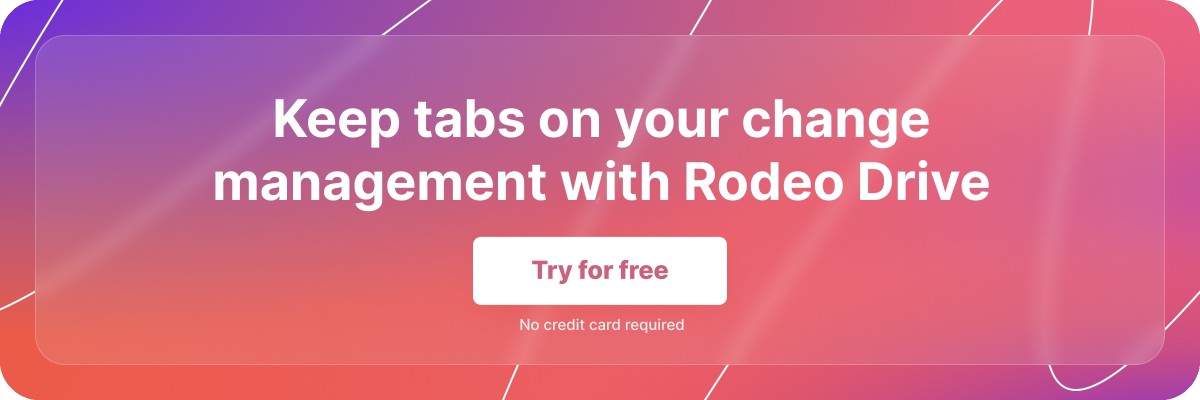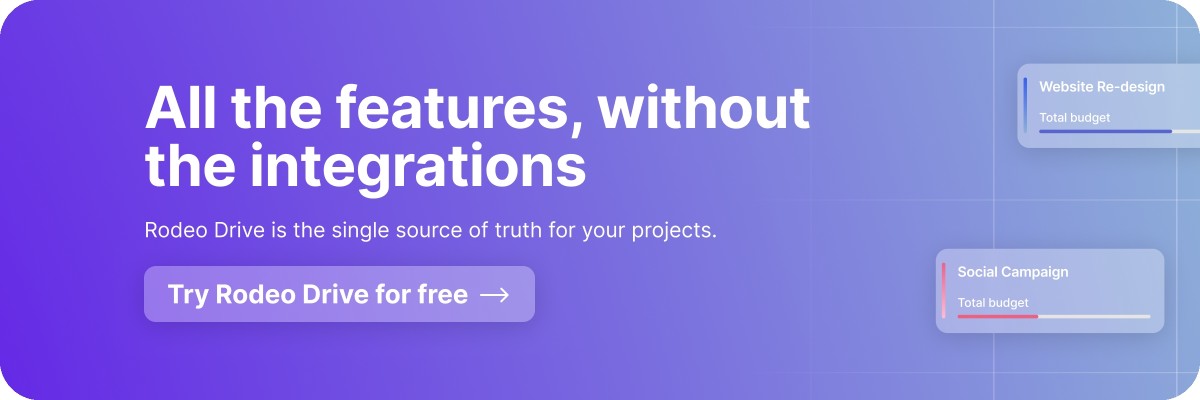Understanding the Role of a Change Control Board in Projects
Seasoned project management professionals know that scope changes and poor decision-making can have severe consequences for the success of a project, which is why many organizations turn to a change control board to help.
In short, a change control board is a group of stakeholders and team members who are responsible for assessing and approving proposed changes to a project after it’s begun.
In this blog, we’ll break down exactly what the change control board is responsible for, best practices for setting one up, and some challenges to familiarize yourself with.
What’s a change control board?
A change control board (CCB) is a group of stakeholders from various departments that leads and oversees the change management process for a project. Without a change control board in place, there’s a risk that proposed changes may clash with your project objectives and constraints.
This means that every time the project team or client wants to make a change to the project, the change control board must meet to evaluate the impact of the change and decide whether it should be made.
Because the change control board is further removed from the project than the project team, they’re better positioned to handle change requests that might have a significant impact on the project. CCB members typically possess a deeper understanding of broader factors that might impact the project’s success as well, such as budget and time restrictions.
What are the change control board’s responsibilities?
So, we’ve established that the change control board is responsible for making change-related decisions for a project. But what does that look like in practice?
Oftentimes, the change review process will begin with the project manager presenting the proposed change to the CCB and explaining the problem it solves and why the change should be a priority. From there, it’s the change control board’s job to determine the best course of action.
The items that fall on the change control board’s plate will likely vary by organization. In general, though, their job includes the following:
Weigh the risks against the benefits of potential project changes
Risk management is an inherent part of change management, which is why a change control board is necessary in the first place. Making risky changes can cause great harm to your project outcomes.
This is where the change control board comes into play, as they need to decide whether a change would help a project more than it harms it.
Let’s consider an example. Say that the client has requested that additional features be added to the project scope. The project manager has passed this request along to the CCB, who needs to decide whether this is a feasible request.
The change control board will need to consider factors like whether this can be delivered within the project’s existing timeline and budget before coming to a final decision. This will require them to ask questions like:
- Does the project team have the capacity to take on additional work?
- Will this request require the project budget to be rearranged?
- How long will this request take to be fulfilled, and is that timeframe feasible given the existing project timeline?
- What are the benefits of implementing this change? What are the risks?
Approve or deny proposed project changes
Projects that have a change control board in place are not allowed to enact proposed changes until the CCB has issued a final approval decision.
Depending on the nature of the project, the change control board might also schedule changes to happen in future stages of the project. For example, if something isn’t a priority now, but there’s an opportunity to fit it in later on, the CCB can approve that as well.

Monitor the implementation of project changes
The change control board’s job isn’t finished once they approve or deny a change. Instead, if a change is approved, they’re responsible for monitoring its outcomes for the rest of the project to ensure that their assessment was correct.
This includes verifying that the change was carried out in accordance with the approved budget and plan to ensure that new risks don’t arise. If any corrective actions are necessary, the change control board can notify the project team of those as well.
Team roles required for a successful change control board
Because the change control board will be making decisions that impact everyone, the right team members must be involved for the project to be successful.
As a result, you’ll want to make your team as cross-functional as possible. This means you’ll need people from a variety of different departments and teams to contribute their unique perspectives on the ways the proposed change might impact the project.
Departments like finance, engineering, or marketing might be ones you’ll want to be represented on the board since project changes might be more likely to impact their teams’ work. However, the necessary departments will vary a lot depending on the nature of your project.
When weighing who should be included on your change control board, expertise and representation are two main factors to keep in mind. Everyone on the CCB will be a decisionmaker, so each key department should have a skilled and experienced member to represent their team.
.png)
Best practices for setting up a successful change control board
Perhaps you’ve practiced change management before, but you’ve never had to set up a change control board before. Don’t worry! Below, we’ve compiled five steps to follow when creating one for the first time.
1. Define the change control board’s purpose
This step is simple, as it’s just defining why the change control board should exist. What should the change control board aim to achieve? Are there existing change management guidelines that the board should be aware of or adhere to? How much leeway does this particular project allow for regarding changes?
2. Determine who needs to be on the board
As we previously discussed, an effective change control board is usually one that’s very cross-functional. The question is, which members are needed for a successful project?
Some CCBs find it useful to devise clear membership guidelines that illustrate who should — and shouldn’t — be included on the board. As part of these guidelines, you might include which departments must be represented, and how much authority each person needs to be considered eligible to become a CCB member.
Once you’ve settled on these guidelines, you’ll want to document them. You can do this as part of your charter, which we’ll cover below.
3. Create a charter to govern the board’s processes
A charter is a good idea for any change control board, as it outlines the procedures that should be followed when it comes to decision-making, as well as other important details, such as membership criteria or a statement of purpose.
Documenting the board’s practices and decision criteria is also helpful for fostering accountability, as team members and other stakeholders can reference it to understand the principles that the board routinely relies on to make decisions.
Related: Why You Need a Project Charter: Benefits and Best Practices
4. Decide how often you’ll meet
The frequency of your meetings will depend on the number of change requests your change control board is tasked with. Urgent requests may call for immediate meetings that aren’t aligned with a set schedule.
That said, having a standing monthly or even weekly meeting is often helpful in overseeing the monitoring portion of change management. At this meeting, you can check in on your project data to ensure that none of the approved changes are having a negative impact on the project.
5. Don’t forget to keep the project team informed on your decisions
Communication is key. Not only is promptly deciding on project changes important, but it’s also important to relay this information to the team in a timely manner.
Every change control board should have some sort of process in place for communication related to the final decisions they make. Will the board inform project managers of their decision via email or will there be a short meeting explaining the decision to the relevant stakeholders every time?
Common challenges change control boards face
Making decisions may seem like an easy job, but don’t be fooled. Serving as a change control board member can be very challenging when everyone has a different perspective on the best way forward.
Here’s an overview of three common challenges that you may face as a member of a change control board.
Approving changes while avoiding scope creep
Approving too many changes can quickly create a landslide that results in scope creep. Scope creep is what happens when a project’s requirements expand beyond what was initially agreed upon, typically making it difficult to deliver the project successfully.
Change control boards are faced with the difficult job of toeing the line between approving necessary changes without causing scope creep. Too many changes to the project’s scope are sure to result in scope creep, but some level of change is necessary for most projects throughout their lifecycle.

Decision-making delays that impact the project timeline
A change control board involves many different team members with many different opinions on the best course of action for a project. Sometimes it’s difficult for change control boards to come to a consensus on what to do.
It’s not uncommon for conflicting opinions to delay the decision-making process, which can result in delays to the project as a whole. Conflict among the CCB can begin to impact the project team’s ability to get work done if decisions aren’t made quickly.
One of the best ways to combat this is by ensuring there are leadership members properly represented on the change control board who are able to step in and take action when things come to a standstill.
Resource constraints that restrict decision-making
Even if a project has several much-needed change requests, oftentimes, resource constraints can get in the way of approving these requests. Most projects have a limited amount of equipment, team members, time, and budget, which makes it unrealistic to accommodate every request.
Navigating which changes are actually necessary for project success is an ongoing challenge that most change control boards will face at some point.
Assess the impact of potential project changes with Rodeo Drive
Once you’ve decided to approve a project change, monitoring its impact on the project is a whole other undertaking. This is where a project management tool like Rodeo Drive can help out.
With budgeting, time tracking, invoicing, and reporting available in a single tool, Rodeo Drive helps teams streamline their workflows to ensure that projects are delivered on time and within budget.
From a change management perspective, this can be used to assess the change’s impact to your project’s budget and your team’s workload capacity to ensure that these changes aren’t having a negative impact on your team’s productivity.
Check out the Rodeo Drive features that allow you to better manage your project changes:
Budgets that automatically update as your team works
Rodeo Drive makes budgeting easy, as project managers are able to build phase-based budgets within the tool according to the different stages of their projects.

Once your team begins working on the project and tracking time toward their various activities, your project budget will update in real-time to reflect the amount of the budget that your team has spent.
This way, the project manager and other stakeholders can keep track of the team’s spending without having to do any math. Simply add an hourly rate card for each team member, enter any expenses, and allow Rodeo Drive to complete the calculations for you.
Access reports on financial health, time registration, and employee productivity
Monitoring the impact of your approved changes without the help of data or reports will be a challenge. This is why Rodeo Drive provides three automatically generated reports to help you better understand where your project stands at all times.
.png)
Under your “Reports” tab on Rodeo Drive, you’ll find reports depicting your project profitability, time registration, and employee productivity. You’ll also have the option of filtering this information by date, client, or project manager.
Plus, exporting this data is easy, should you want to create your own custom reports. All data based on your usage of Rodeo Drive can be exported as an Excel or CSV file.
Don’t just take our word for it. Come explore Rodeo Drive for yourself by signing up for a free trial.








